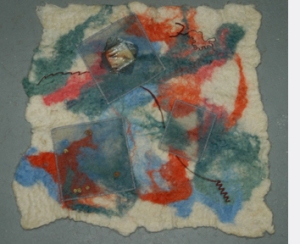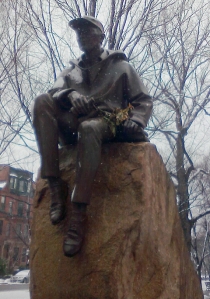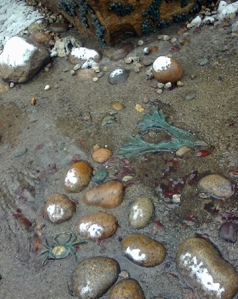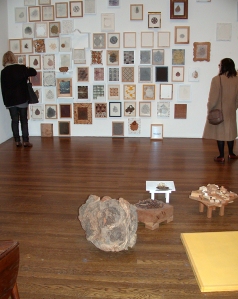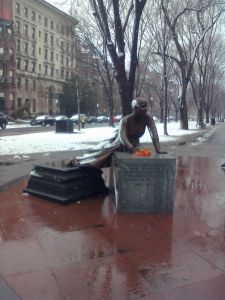 The Boston Women’s Monument is a triad of bronze sculptures by Meredith Bergmann, representing Lucy Stone, Abigail Adams, and Phyllis Wheatley. The monument was roundly panned by Boston art critics when it was installed. There are many awkward things about the group, certainly (for instance, why does Abigail Adams lurk behind an obelisk that reminds me of 2001?) but even on the gray March day in my photograph, there were visitors. Dressed in raincoats and bundled against the chill, they posed with the sculptures–really posed with them, since Lucy, Abigail and Phyllis are at ground level. Someone else–earlier in the day or perhaps the day before–had left a bouquet of orange chrysanthemums in Lucy Stone’s hand. Representational sculpture serves an ancient need, to present us with a real person, and that elicits a physical, visceral response.
The Boston Women’s Monument is a triad of bronze sculptures by Meredith Bergmann, representing Lucy Stone, Abigail Adams, and Phyllis Wheatley. The monument was roundly panned by Boston art critics when it was installed. There are many awkward things about the group, certainly (for instance, why does Abigail Adams lurk behind an obelisk that reminds me of 2001?) but even on the gray March day in my photograph, there were visitors. Dressed in raincoats and bundled against the chill, they posed with the sculptures–really posed with them, since Lucy, Abigail and Phyllis are at ground level. Someone else–earlier in the day or perhaps the day before–had left a bouquet of orange chrysanthemums in Lucy Stone’s hand. Representational sculpture serves an ancient need, to present us with a real person, and that elicits a physical, visceral response.
Art and Sculpture Schools
Business and Legal Resources for Artists
Foundries
Grants and Residencies
Inspiration/General
Public Art by Women
Sculpture Materials
Archives
- April 2024
- March 2024
- February 2024
- January 2024
- November 2023
- October 2023
- August 2023
- July 2023
- June 2023
- May 2023
- April 2023
- February 2023
- January 2023
- December 2022
- September 2022
- August 2022
- July 2022
- June 2022
- February 2022
- January 2022
- December 2021
- October 2021
- July 2021
- June 2021
- April 2021
- March 2021
- February 2021
- October 2020
- September 2020
- August 2020
- July 2020
- February 2020
- January 2020
- December 2019
- November 2019
- October 2019
- September 2019
- August 2019
- July 2019
- June 2019
- May 2019
- April 2019
- March 2019
- February 2019
- January 2019
- December 2018
- November 2018
- October 2018
- September 2018
- August 2018
- July 2018
- June 2018
- May 2018
- April 2018
- March 2018
- February 2018
- November 2017
- August 2017
- July 2017
- May 2017
- April 2017
- March 2017
- February 2017
- January 2017
- December 2016
- June 2016
- May 2016
- April 2016
- March 2016
- February 2016
- January 2016
- December 2015
- August 2015
- July 2015
- May 2015
- April 2015
- March 2015
- February 2015
- December 2014
- July 2014
- June 2014
- May 2014
- April 2014
- March 2014
- February 2014
- January 2014
- December 2013
- November 2013
- September 2013
- July 2013
- June 2013
- May 2013
- April 2013
- March 2013
- January 2013
- October 2012
- September 2012
- August 2012
- July 2012
- June 2012
- May 2012
- April 2012
- March 2012
- February 2012
- January 2012
- December 2011
- November 2011
- October 2011
- September 2011
- August 2011
- May 2011
- April 2011
- March 2011
- February 2011
- January 2011
- September 2010
- August 2010
- July 2010
- June 2010
- April 2010
- March 2010
- January 2010
- December 2009
- November 2009
- October 2009
- September 2009
- August 2009
- July 2009
- June 2009
- May 2009
- April 2009
- March 2009
- February 2009
